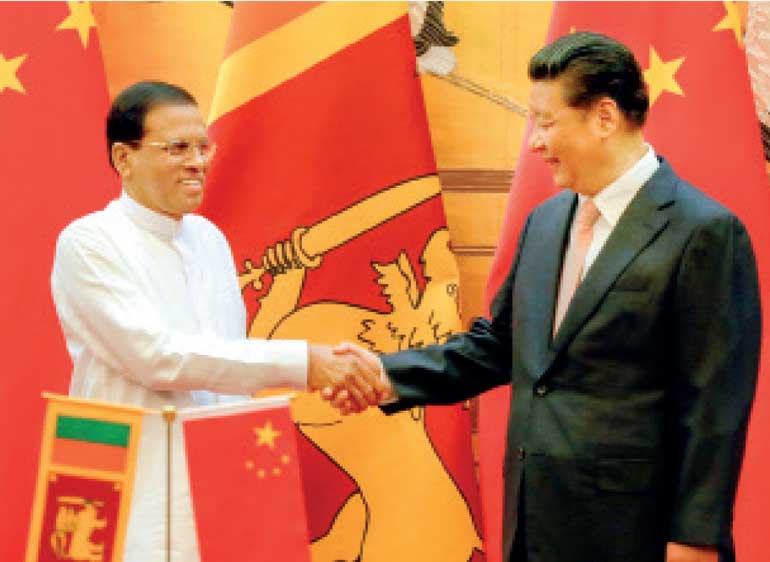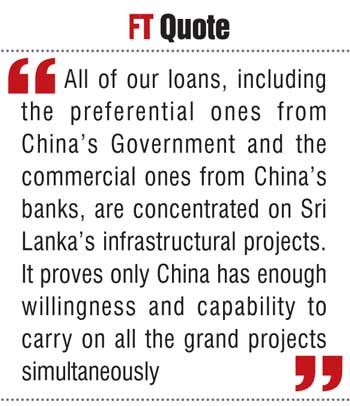Monday Dec 22, 2025
Monday Dec 22, 2025
Monday, 23 October 2017 00:19 - - {{hitsCtrl.values.hits}}
By Dr. Liu Xiaoxu
There have been questions in Sri Lanka whether China has funded Sri Lanka too much to go beyond the latter’s credit sustainability and whether Chinese investments can make a profit in this land in the Indian Ocean. Sri Lanka is not small but is almost two times the size of Taiwan with the same population but one-sixth of the GDP of Taiwan. The third issue is whether there is any corruption in the projects awarded to China’s companies.
As for the first question, no one can get an exactly accurate debt threshold for any economy, even those geniuses on Wall Street cannot do this otherwise we would have never seen the breakout of the financial crisis. The motto serving a capitalist best is ‘more risks, more profits’, the same is true for any market economy. The previous Government valued the precious timing brought by the final peace and enthusiasm of foreign investors towards the once nearest-to-taking off-economy in the South Asian continent, borrowing huge money at the lowest costs to develop and upgrade the roads, the power stations, the ports and the airports. Have you noticed how much your transportation system lags behind East Asian countries? Less than 200 kilometres in distance from Kandy to Colombo takes four hours by car and three hours by a rocky train ride.

In spite of lots of potential investors, the World Bank is very interested in social development issues, like gender equality, poverty elimination, giving a school here and building a health centre there. While the ADB can invest in infrastructure, Sri Lanka has to compete with the rest of Asia’s developing countries. As for Japan, due to its rigid procuring policy and continuously appreciating yen, the loan by the Japan International Cooperation Agency (JICA) is not so much cheap in practice as it seems in its terms.
These are among the possible reasons why Sri Lanka and China have found some common ground. To date 70% of Chinese assistance to Sri Lanka is through preferential loans with interest rates less than 2%, which surely is not the lowest ones, why should we? In China we still have a population of 50 million living below the poverty line, and in the domestic market we still keep the lending rate around 5% for our own enterprises.
All of our loans, including the preferential ones from China’s Government and the commercial ones from China’s banks, are concentrated on Sri Lanka’s infrastructural projects. It proves only China has enough willingness and capability to carry on all the grand projects simultaneously. The reason why the previous Government was so eager to tap the potential of the country was not only the consideration of votes but maybe the desire to mend up all the years Sri Lanka has missed during the ethnic conflict. Politicians are not saints but sometimes they do have good intentions. Don’t let too much cynicism blind visionary eyes.
Strategic interest or illusion
China has no strategic illusion about Sri Lanka, which is too close to India geographically to resist any influence from its powerful northern neighbour, neither is there any deliberate or insidious plan to trick Sri Lanka into a debt trap. Nor is it economically naïve to squander money building the largest swimming pool in a tiny island which is thousands of miles away from it.
Actually, China is even more confident in Sri Lanka than the Sri Lankans. With its great location in the Indian Ocean, especially Hambantota, Sri Lanka can turn into an important trans-shipment hub in the region.
In Sri Lanka very few people know China Merchant Port Holdings (CMP), the bidder and future operator of the port, and show no interest in getting to know it. CMP was founded in 1872.With long experience in running ports, it has now grown into a diversified conglomerate with great strength.

CMP has invested and run the South Container Terminal of Colombo for a while and reached its full handling capacity in no time. Therefore CMP saw the great potential for Sri Lanka as a trans-shipment hub, for most cargo is not serving Sri Lanka’s inland market but instead goes to India and beyond. That is why it shows strong confidence in the profitability of the Hambantota port. For the Sri Lanka Government, leasing land to CMP is a way not only to reduce interest payment but also to increase tax revenue thanks to successful port running in the future. For CMP it is just another kind of BOT - build, operate and transfer - not much different from the original form.
As to why CMP needs so many wide lands and so many docks for the port, we can guess, because for some industry, scales of economy are a must. Through improved connectivity, rapid industrialisation and urbanisation, China has raised hundreds of millions of people out of abject poverty. Hambantota is also a poverty-stricken region in Sri Lanka. This time, give CMP a try, maybe they will in return give the locals a more beautiful tomorrow.
Corruption is an inevitable product of bad governance. Only transparency can kill it. Since all men make mistakes, rule of law can effectively pre-empt some of these. According to the international business norm, all the infrastructure projects should go through tender competition, except there is no competitor at all.
I am very sure for any outsider it would be very difficult to get any hint of the cost of a giant project, even worse those insiders are always sneakily hiding something from you. After all, an enterprise has no obligation to save money for a consumer who seems totally mindless of his own money. Therefore, it’s the Government and the legal system that are responsible to contain corruption instead of asking a foreign company to voluntarily hold an anti-corruption banner and make all its business information public unless the law forces it to.
(The writer is a Senior Research Associate of the China Academy for Social Sciences (CASS))